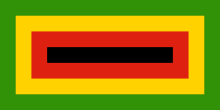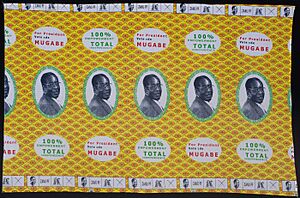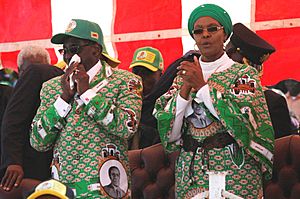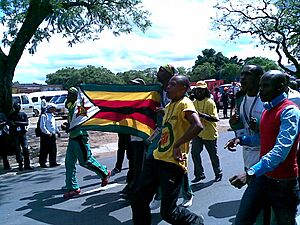ZANU–PF facts for kids
Quick facts for kids
Zimbabwe African National Union – Patriotic Front
|
|
|---|---|
| Abbreviation | ZANU–PF |
| First Secretary | Emmerson Mnangagwa |
| Second Secretaries | Constantino Chiwenga Kembo Mohadi |
| National Chairperson | Oppah Muchinguri |
| Founder | Enos Nkala, Herbert Chitepo, Ndabaningi Sithole, Robert Mugabe, Edgar Tekere |
| Founded | 8 August 1963 |
| Headquarters | ZANU–PF Building Harare, Zimbabwe |
| Youth wing | ZANU–PF Youth League |
| Women's wing | ZANU–PF Women's League |
| Membership (2022 est.) | 3,900,000 |
| Ideology | Populism |
| Regional affiliation | Former Liberation Movements of Southern Africa |
| International affiliation | For the Freedom of Nations! Socialist International (2008–2017) |
| Colours | Green, yellow, red, black |
| National Assembly |
191 / 280
|
| Senate |
33 / 80
|
| Party flag | |
 |
|
The Zimbabwe African National Union – Patriotic Front (ZANU–PF) is a political party that has been in charge of Zimbabwe since the country became independent in 1980. For many years, Robert Mugabe led the party. He was first the prime minister and then the president from 1987. In 2017, he was removed as leader.
In the 2008 election, ZANU–PF lost its full control of parliament for the first time. They then made a power-sharing agreement with another party, the Movement for Democratic Change – Tsvangirai (MDC). ZANU-PF won the 2013 election and also the 2018 election.
On 19 November 2017, after a big change in government, ZANU–PF removed Robert Mugabe as their leader. He resigned two days later. Emmerson Mnangagwa, who was a Vice President, took his place.
Contents
History of ZANU–PF
How ZANU–PF Started (1955–1963)
Before ZANU–PF, there were other groups fighting for African people's rights in Southern Rhodesia (which is now Zimbabwe). The first group was the City Youth League (CYL), formed in 1955. This group wanted "one man, one vote", meaning everyone should have the right to vote.
Later, the CYL joined with another group to form the Southern Rhodesia African National Congress (SRANC) in 1957. Joshua Nkomo became its president. This group wanted African majority rule, but the government banned it in 1959.
New groups like the National Democratic Party (NDP) and the Zimbabwe African People's Union (ZAPU) were formed. They had similar goals but were also banned. Many leaders were arrested.
Forming ZANU (1963)
In the 1960s, there were disagreements among African nationalist leaders. Some leaders, like Ndabaningi Sithole and Robert Mugabe, felt that Joshua Nkomo was not leading effectively.
On 8 August 1963, these leaders, including Sithole, Herbert Chitepo, Leopold Takawira, Edgar Tekere, Henry Hamadziripi, Mukudzei Midzi, and Enos Nkala, formed their own group called the Zimbabwe African National Union (ZANU).

ZANU promised to change unfair land laws and create a "bill of rights" to protect everyone's freedoms. They said they were "nonracial," meaning they would welcome people of all backgrounds.
After ZANU was formed, there were often fights between supporters of ZAPU and ZANU. ZAPU was stronger in some areas, while ZANU gained support in others. ZANU presented itself as being more direct in challenging white-minority rule.
The Bush War (1964–1980)
ZANU held its first big meeting in May 1964. There, Ndabaningi Sithole was chosen as the first president, and Robert Mugabe became the secretary-general. ZANU stated its goals were democracy, socialism, and freedom for all.
The Patriotic Front (PF) was created as a team-up between ZAPU and ZANU. They worked together to fight against white minority rule in Rhodesia (now Zimbabwe). ZAPU had a military group called the Zimbabwe People's Revolutionary Army (ZIPRA), and ZANU had its own fighters called the Zimbabwe African National Liberation Army. Their main goal was to remove the white-minority government led by Ian Smith.
After Independence
Their shared goal was achieved in 1980. The United Kingdom gave Zimbabwe its independence after a short period of British control. In the 1980 election, ZANU–Patriotic Front (ZANU–PF) and Patriotic Front–ZAPU (PF–ZAPU) ran separately. Robert Mugabe and ZANU–PF won the election.
In December 1987, ZAPU joined with ZANU to form the official ZANU–PF. This happened after a period of conflict.
From 1999 to 2017, Robert Mugabe and ZANU–PF faced strong opposition from the Movement for Democratic Change.
In 2004, Joice Mujuru became the first woman to be a vice president of the party.
In the 2005 parliamentary elections, ZANU–PF won many seats. However, some groups said the election was unfair, mentioning "ghost voters" on the voting lists.
In the 2008 election, ZANU–PF lost its majority in parliament for the first time since independence.

In the 2008 presidential election, Morgan Tsvangirai from the MDC received the most votes, but not enough to win outright. A second round of voting was needed. However, Tsvangirai pulled out, saying the election was not fair. Robert Mugabe was then re-elected.
Many people blamed ZANU–PF for not dealing with the 2008 Zimbabwean cholera outbreak, which caused many deaths.
Later, a Government of National Unity was formed between ZANU–PF and the MDC parties to work together.
Changes After Mugabe

Around 2014, there was a struggle within ZANU–PF over who would take over from President Robert Mugabe. Vice President Joice Mujuru and Justice Minister Emmerson Mnangagwa were seen as possible successors.
Mujuru was removed from the party in 2015. Then, a new power struggle began between Mnangagwa's group and Grace Mugabe's group.
On 15 November 2017, the military took control in Zimbabwe. President Robert Mugabe was placed under house arrest. ZANU–PF then voted to remove Robert Mugabe as party leader and put Emmerson Mnangagwa in charge. Robert Mugabe resigned on 21 November 2017. Mnangagwa became the new President of Zimbabwe on 24 November 2017.
Robert Mugabe passed away on 6 September 2019. Emmerson Mnangagwa continued as President.
In the March 2022 by-elections, ZANU–PF did not perform as well as the Citizens Coalition for Change. However, ZANU–PF won the 2023 Zimbabwean general election.
ZANU–PF's Beliefs
ZANU–PF says it is against imperialism (when one country controls another) and supports pan-Africanism (the idea of a united Africa). Others describe it as an African nationalist party. The party has a main committee called the Central Committee.
Land Redistribution
ZANU–PF has focused on giving land back to black Zimbabweans. In the 2000s, Robert Mugabe encouraged taking commercial farms, which were mostly owned by white people, to give to landless black people.
However, when President Mnangagwa took office, he said the government would work on a plan to pay former landowners. In 2018, he also said that foreign investments would be safe in Zimbabwe.
How ZANU–PF is Organized
ZANU–PF has a structured organization. It includes:
- The National People's Congress
- The Central Committee
- The Women's League
- The Youth League
- And various committees at different levels, from provinces down to local villages.
The current first secretary of ZANU–PF is President Emmerson Mnangagwa. The other top leaders are Second Secretaries Constantino Chiwenga and Kembo Mohadi, and National Chairperson Oppah Muchinguri.
The party also has a Women's League, a Youth League, and a War Veterans' League, which was started in 2022.
Party Meetings (Congresses)
- 1st National People's Congress (December 1989)
- 2nd National People's Congress (December 1994)
- 3rd National People's Congress (December 1999)
- 4th National People's Congress (December 2004)
- Extraordinary Congress (December 2007)
- 5th National People's Congress (December 2009)
- 6th National People's Congress (December 2014)
- Extraordinary Congress (12–17 December 2017)
- 7th National People's Congress (December 2022)
ZANU–PF's International Connections
ZANU–PF is part of the Former Liberation Movements of Southern Africa. This is a group of political parties from Southern Africa that were involved in fighting for independence from colonial rule.
ZANU–PF used to be connected with the Socialist International (SI), a worldwide organization of socialist parties. However, they have not attended SI meetings since 1999. The Socialist International has criticized the actions of Zimbabwe's government, which is led by ZANU–PF.
Election Results
Presidential Elections
| Election | Party candidate | Votes | % | Votes | % | Result |
|---|---|---|---|---|---|---|
| First Round | Second Round | |||||
| 1990 | Robert Mugabe | 2,026,976 | 83.05% | — | — | Elected |
| 1996 | 1,404,501 | 92.76% | — | — | Elected |
|
| 2002 | 1,685,212 | 56.20% | — | — | Elected |
|
| 2008 | 1,079,730 | 43.24% | 2,150,269 | 90.22% | Elected |
|
| 2013 | 2,110,434 | 61.88% | — | — | Elected |
|
| 2018 | Emmerson Mnangagwa | 2,460,463 | 51.44% | — | — | Elected |
| 2023 | 2,350,711 | 52.60% | — | — | Elected |
|
National Assembly Elections
| Election | Party leader | Votes | % | Seats | +/– | Position | Result |
|---|---|---|---|---|---|---|---|
| 1980 | Robert Mugabe | 1,668,992 | 62.99% |
57 / 100
|
Majority government | ||
| 1985 | 2,233,320 | 77.19% |
64 / 100
|
Majority government | |||
| 1990 | 1,690,071 | 80.55% |
117 / 120
|
Supermajority government | |||
| 1995 | 1,143,349 | 81.38% |
118 / 120
|
Supermajority government | |||
| 2000 | 1,211,284 | 48.47% |
62 / 120
|
Majority government | |||
| 2005 | 1,569,867 | 59.59% |
78 / 120
|
Majority government | |||
| 2008 | 1,110,649 | 45.84% |
99 / 210
|
ZANU PF–MDC coalition government | |||
| 2013 | 2,116,116 | 63.16% |
196 / 270
|
Supermajority government | |||
| 2018 | Emmerson Mnangagwa | 2,477,708 | 52.35% |
179 / 270
|
Majority government | ||
| 2023 | 2,515,607 | 56.18% |
177 / 280
|
Majority government |
Senate Elections
| Election | Party leader | Votes | % | Seats | +/– | Position | Result |
|---|---|---|---|---|---|---|---|
| 2005 | Robert Mugabe | 449,860 | 73.71% |
43 / 66
|
Governing majority | ||
| 2008 | 1,101,931 | 45.79% |
57 / 93
|
ZANU PF–MDC governing coalition | |||
| 2013 | 2,120,634 | 64.27% |
37 / 80
|
Governing minority | |||
| 2018 | Emmerson Mnangagwa | — | — |
34 / 80
|
Governing minority | ||
| 2023 | — | — |
33 / 80
|
Governing minority |
See also
 In Spanish: Unión Nacional Africana de Zimbabue - Frente Patriótico para niños
In Spanish: Unión Nacional Africana de Zimbabue - Frente Patriótico para niños
- List of political parties in Zimbabwe
- List of ruling political parties by country
- Politics of Zimbabwe


